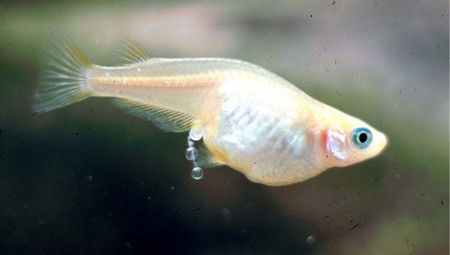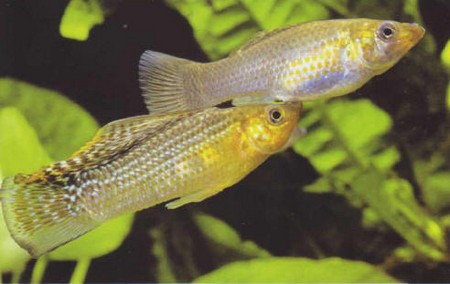The livebearers include some of the most popular tropical aquarium fish; this is partly because, as well as being highly attractive, they breed readily and are relatively easy to keep. This group includes fish as diverse as guppies, many with outsize, flamboyant tails, fiery-coloured platies, black and marbled mollies, and halfbeaks with their curious, jutting lower jaw.
Guppies
Named after the naturalist Robert J. L. Guppy, these were one of the first tropical fish to be kept in the early 1900s. Guppies {Poecilia reticulata) are now bred in a huge range of colour forms and patterns, and many have fancy fins or an especially enlarged tail.
For both the highly bred and the less showy wild forms, sexing is straightforward because females are distinctly larger and less colourful than males. It is often advisable to buy young fish, particularly if you want to breed your own stock, because adult females are likely to have mated. If selecting adult fish, choose large females because they are likely to produce more fry.
Swordtail
The swordtail (Xiphophorus helleri) derives its name from the male of the species; the lower part of his caudal fin (tail) is typically elongated, like a sword. The native form is green but this is considerably less striking than the various colour strains that have been developed through breeding, of which the best known and most common is the red variety. A curious fact about the swordtail is that females may sometimes switch sex and become male, particularly if old.
Platies
Another livebearer that has been developed in many different varieties is the platy (Xiphophorus maculatus). Like most other livebearers, platies are peaceful and easy to keep, and they are prolific breeders. These are relatively short, rotund fish and significantly smaller than the swordtail.
One of the most popular forms is the wagtail platy, with an orange body that contrasts strikingly with its black fins and mouth. Some hybrids have variations to the fins, most notably the hi-fin, which has a raised, enlarged dorsal fin. A slightly larger form of the platy occurs in Mexico. Sometimes called the variegated platy (X. variatus), this has a more elongated body shape and some forms are brightly coloured.
Some platies more closely resemble the wild species, having a dark, crescent-shaped marking at the base of the caudal fin – because of this, they are sometimes called moon fish. Sexing is easy: females have a fan-shaped anal fin, whereas that of the male looks tubular, and serves as the gonopodium for fertilization.
Less obviously striking than its highly bred relatives, even the wild guppy (Poecilia reticulata) is an attractive specimen. It hails from South America and neighbouring Caribbean islands.
Mollies
As well as the well-known and popular black molly, other mollies have also become prominent in recent years. Many of the newer strains have enlarged dorsal fins. These are derived from sailfin mollies (Poecilia latipinna). In the wild, these fish are primarily silver, with bluish-green iridescence on their bodies. Various colour varieties are now firmly established, including the platinum which has no colour on its body, darkly marbled forms, and even the rather grotesque balloon molly, which has a distorted body with a high back and an outsize, balloon-shaped belly.
The correct water conditions are vital when keeping mollies, and it is advisable to add some aquarium salt to their water in the recommended amount. Mollies naturally inhabit brackish water, and they are more prone to fungus than other livebearers, especially if kept in pure fresh water. Check on their water conditions at the time of purchase, because they will be most vulnerable after a move to new surroundings. Black mollies in particular may also be susceptible to white spot.
Other liverbearers
Although less commonly available, there are other livebearers which make fascinating additions to an aquarium. Halfbeaks (Dermogenys pitsillus), which inhabit both brackish and freshwater areas, are most notable for their curious, elongated lower jaw.
The breeding requirements of members of the family Goodeidae, such as the golden bumblebee goodeid (Allotoca dugesi), are unusual among livebearers. The females appear to be unable to store sperm, and so these fish must be kept in pairs if breeding is to be successful. The gestation period is also lengthy and the young fish are nourished internally inside their mother’s body. Unfortunately, these interesting fish are not commonly available.
They are sometimes called wrestling halfbeaks – owing to the males’ habit of engaging in trials of strength, locking jaws with each other for up to half-an-hour. These jaws are quite easily damaged, so it is best to keep males apart, housing a single male with several females (easily recognized by their fan-shaped anal fin).
Gravid (pregnant) females must be left undisturbed; in favourable conditions, they may breed every four to eight weeks. Stick paper round the lower part of the aquarium, otherwise the young fish may try to swim through the glass at first, and damage their prominent jaw. You can also help to avoid this problem by using aquatic plants to demarcate the confines of the tank.
Among other livebearers that you may encounter is the mosquito fish (Helerandria formosa), which prefers relatively low water temperatures. The tiny males rank as one of the smallest fish in the world. Females have a relatively long birth period, producing their brood over the course of about two weeks.

